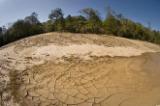 © Steve Vaughn/Panoramic Images (Florida Title Image Large)
© Steve Vaughn/Panoramic Images (Florida Title Image Large)

Ecoregions in Florida
What are ecoregions?
Ecoregions reflect broad ecological patterns occurring on the landscape. In general, each ecoregion has a distinctive composition and pattern of plant and animal species distribution. Abiotic factors, such as climate, landform, soil, and hydrology are important in the development of ecosystems, and thus help define ecoregions. Within an individual ecoregion, the ecological relationships between species and their physical environment are essentially similar.
Why use ecoregions?
Using ecoregions as a framework for assessing the distribution and status of species and ecosystems makes biological sense, compared to using politically derived lines like county, state or national boundaries. Ecoregions also provide an ecological basis for partitioning the state into subunits for conservation planning purposes.
What ecoregions occur in Florida?
Florida’s borders contain portions of five ecoregions according to The Nature Conservancy, each of which is described on the following pages. These descriptions are intended to provide the reader with a snapshot of each ecoregion, and the statements regarding biodiversity highlights and conservation needs are not meant to be comprehensive.
One alternative to The Nature Conservancy ecoregions presented on LandScope America are those developed by Omernik for the U.S. Environmental Protection Agency. Omernik identifies 13 ecoregions for Florida.
Learn more about the EPA Ecoregions of Florida
Ecoregions of Florida
-
East Gulf Coastal Plain
The East Gulf Coastal Plain ecoregion encompasses portions of five states (Georgia, Florida, Alabama, Mississippi, and Louisiana) and over 42 million acres from the southwestern portion of Georgia across the Florida Panhandle and west to the southeastern portion of Louisiana.
-
Florida Peninsula
Although it is fragmented by three Interstate highways and the prominent, sprawling metropolitan areas of Orlando and Tampa, the Florida Peninsula also features several large managed areas that form a basis for natural resource conservation.
-
South Atlantic Coastal Plain Ecoregion
The South Atlantic Coastal Plain ecoregion encompasses more than 23 million acres across three states, including the southern portion of South Carolina, southeastern Georgia and northeastern Florida.






